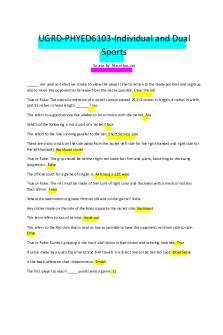Dual rate PDF

| Title | Dual rate |
|---|---|
| Author | Daroun Aziz |
| Course | Regnskab, intern |
| Institution | Syddansk Universitet |
| Pages | 3 |
| File Size | 119.8 KB |
| File Type | |
| Total Downloads | 106 |
| Total Views | 138 |
Summary
Download Dual rate PDF
Description
DUAL RATE COST ALLOCATIONS IN COST ACCOUNTING In cost accounting, the dual rate cost allocation methodcategorizes cost into two types of cost pools: fixed costs and variable costs. You calculate a different cost allocation rate for each cost pool. A more specific review of costs leads to more precise cost allocations. Say you manage an online tutoring business. Your instructors serve two markets — high school students and adult continuing education students — so your firm has a high school division and an adult ed division. Both company departments use technology in a big way. Your computer department (called information technology, or IT) installs software, trains staff, backs up data, and repairs computers. Assume your IT department with a budgeted fixed cost allocation rate of $625 per unit. Here’s a two-step process to calculate the dual rate cost allocation of the IT department: Multiply the budgeted fixed cost allocation rate by the budgeted usage Multiply the budgeted variable cost allocation rate by the actual usage Note that the cost allocation rates are multiplied by different usage amounts. Here’s a way to keep the difference straight: It’s possible that your budgeted fixed cost come in as planned. In fact, your fixed cost may involve a contract (lease agreement, insurance premiums) that cannot change after budgeting. That’s a way of remembering that you use budgeted usage for fixed cost allocations.
Variable costs are harder to pin down in planning, so you use actual usage for the variable cost allocations. The first table shows the total budgeted fixed cost for the IT department. Dual Rate Allocation — Total Budgeted Fixed Cost
Fixed Allocation Rate
Budgeted Usage Hours
Budgeted Fixed Costs
1,500
$937,500
1,700
$1,062,500
High school division
$625 Adult education division
$625
The next step for a dual rate calculation is to compute the variable costs. Using the IT department example, you see the related info in the second table. Dual Rate Allocation — Total Variable Cost
Variable Allocation Rate
Actual Usage Hours
Budgeted Fixed Costs
1,300
$260,000
1,800
$360,000
High school division
$200 Adult education division
$200
Using the dual rate method of allocation, the total IT department cost allocated to the high school division would be High school division IT department cost allocation = fixed costs + variable costs High school division IT department cost allocation = $937,500 + $260,000 High school division IT department cost allocation = $1,197,500 The adult education division’s cost allocation is $1,422,500 ($1,062,500 fixed cost + $360,000 variable cost). If you add the two allocations, you get $2,620,000, the total IT department allocation. Consider why the dual rate cost allocation total is different. It’s because the fixed portion of the allocation is based on budgeted information only. The fixed cost rate and usage are both budgeted amounts. You calculate variable costs as budgeted variable cost rate x actual hours of usage. The dual rate method allocates your costs more precisely than the single rate process. That’s because the dual rate method separates the analysis of fixed and variable costs. A more precise allocation means that your full product cost is more accurate....
Similar Free PDFs

Dual rate
- 3 Pages

espacio dual
- 2 Pages

Moffitt’s Dual Taxonomy Theory
- 3 Pages

Individual and dual sports
- 6 Pages

Caso clínico: \"Patología dual\"
- 4 Pages

Metodo DUAL Simplex
- 6 Pages

Module 1 Dual Stunts
- 12 Pages

Dual space - Apuntes 3
- 11 Pages

Individual Dual Sports
- 166 Pages

Double dual supplement
- 2 Pages

3.3 Relación primal-dual
- 15 Pages

Manual Kaon Dual - Nada interesante
- 13 Pages

Dual Polarity DC Power SUply
- 1 Pages
Popular Institutions
- Tinajero National High School - Annex
- Politeknik Caltex Riau
- Yokohama City University
- SGT University
- University of Al-Qadisiyah
- Divine Word College of Vigan
- Techniek College Rotterdam
- Universidade de Santiago
- Universiti Teknologi MARA Cawangan Johor Kampus Pasir Gudang
- Poltekkes Kemenkes Yogyakarta
- Baguio City National High School
- Colegio san marcos
- preparatoria uno
- Centro de Bachillerato Tecnológico Industrial y de Servicios No. 107
- Dalian Maritime University
- Quang Trung Secondary School
- Colegio Tecnológico en Informática
- Corporación Regional de Educación Superior
- Grupo CEDVA
- Dar Al Uloom University
- Centro de Estudios Preuniversitarios de la Universidad Nacional de Ingeniería
- 上智大学
- Aakash International School, Nuna Majara
- San Felipe Neri Catholic School
- Kang Chiao International School - New Taipei City
- Misamis Occidental National High School
- Institución Educativa Escuela Normal Juan Ladrilleros
- Kolehiyo ng Pantukan
- Batanes State College
- Instituto Continental
- Sekolah Menengah Kejuruan Kesehatan Kaltara (Tarakan)
- Colegio de La Inmaculada Concepcion - Cebu


